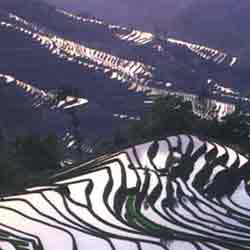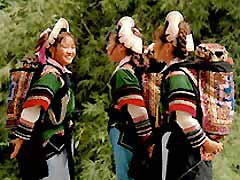
Regarded by Chinese travelers as one of China's 17 most beautiful scenic areas, Yuanyang County is in the depths of the Ailao Mountains in Honghe Hani and Yi Autonomous Prefecture, southern Yunnan Province. The prefecture has an area of more than one million Mu in terraced fields, the core 300,000 Mu of which are in Yuanyang.
Villagers have inhabited the county for generations. Happy with their peaceful life, they seldom leave, other than to replenish supplies at the local market town.
Magnificent Terraces
Yuanyang County is world famous for its Hani ethnic minority-constructed farming terraces that zigzag upwards over range upon range of slopes to a height of 144 to 2,000 meters. As the Hani people say, they can build and water terraces on any mountain, no matter how tall.
Officials from the county tourism bureau recall proudly the many overseas researchers and visitors that have come to see the terraces. One official commented, "Most tourists cannot believe that the Hani people cultivate terraces using only simple hoes. They regard them as every bit as splendid as the Great Wall and the Pyramids."
The terraces have a 1,300-year history, and in that time Hani farmers have perfected a rice terrace-oriented farming and seeding ecosystem. For the past 50 years, the terraces have produced between 100 to 150 kilograms, sometimes as much as 300 kilograms, of rice per Mu (a sixth of an acre), an output that compares with that of any plains area. Incredibly enough, Yuanyang, with its high mountains and steep valleys and forests, is actually a huge granary in Yunnan Province that was relied on heavily in the 1960s and 1970s to alleviate famine in the inland areas.
The Hani terraces and their irrigation system constitute ingenious agricultural innovation. Ailao Mountain's temperate climate and large scope of vegetation assures precipitation adequate to water the terraces, but equal apportionment of water to each plot on each terrace requires specialized skill. The Hani people call their method of water management, "Carving Wood to Ration Water"; villagers from each household mark different gradations on a wooden cross and place it in front of the terrace's source of water. When water flowing into the terraces reaches a specific gradation, the flow ceases. This system ensures enough water for every terraced plot.
Shi Junchao, who has spent many years on research into Hani Culture, says, "As the Hani people rely on the terraces for their subsistence, there has evolved a terrace "culture," apparent in folk customs such as the Name Giving Ceremony. When a baby boy is born, a field plowing ceremony is held, whereby make-believe terraces are drawn on the courtyard floor and a seven-or eight-year-old boy apes the hoeing process. If the infant is a girl, a seven-or eight-year-old girl mimes field work with a basket on her back. It is after the ceremony that the infant is given a name and declared a true member of the village. When someone passes away, he or she is buried on the slope beside the terrace to guard it from the nether world.
Hani Fashion

The dark blue garments and silver jewelry worn by Hani women create a simpler, more elegant impression than the attire of many other ethnic minorities in southern Yunnan. Hani girls most enjoy window-shopping at the silversmith's shop in town. The silversmith came to Yuanyang from Sichuan Province more than ten years ago, and business in this small town has been brisk enough to enable him to send his two children to school in Shanghai. He says that to Han people, silver jewelry is purely decoration, but for the Hani people it has many cultural connotations.
As the Silk Road and the Tea and Horse Trails passed through southern Yunnan, about 19 silversmiths settled in the province during the Kangxi reign of the Qing Dynasty and helped to make the province famous for its silver goods. Southern Yunnan was once prosperous, having been the trading center for the metallic minerals, timber and biological resources needed inland. It was during the Ming and Qing dynasties (1368-1911) that silver coins began to be minted. Extended periods of self-sufficiency and low circulation of commodities prompted the Hani people to fashion silver coins into jewelry worn as an indication of the level of family wealth. Hani women still abide by this tradition and keep the town silversmith busy. He is handed dozens of silver coins at a time with the request that they be melted down and forged into hair ornaments, necklaces and other items of jewelry. Hani women wear their silver ornamentations in layers reminiscent of the terraces that are their livelihood, and the crab, mussel or waterwheel designs carved on each piece express the Hani reverence for water.
In his work Memories of the Yunnan Horse Racing Festival, famous modern writer Shen Congwen made plain that the main attraction for women at the event was the presence of the master silversmith from the market town, who crafted pieces of jewelry in novel designs on the spot. His materials spread on a piece of cloth on the smooth ground, the silversmith would smelt, forge, drill, gilt, inlay and joint silver into one-off designs on request. Silver jewelry of the Qing Dynasty or the Republican period can still be bought at the market town today.
Travel Tips:
Local customs—the Long Street Banquet
The Hani New Year, called Angmatu, is celebrated early in the tenth lunar month. The festival lasts 6 days, during which Hani people get together to worship water, the dragon and heaven in expectations of a bumper grain harvest and favorable weather for the coming year.
On the second day of Angmatu, each household contributes to the preparation of 40 Hani style chicken, fish, and minced pork dishes. These are placed on a 700-meter-long dragon-shaped chain of tables from each household in the main street. The street banquet then commences, amid a festive atmosphere of crashing gongs and thundering drums. All participants, young and old, dress in their best. The villagers select an elder male of good moral standing and reputation to sit at the head of the banqueting table. When the time comes to offer sacrifice, his task is to slaughter domestic animals and offer them to the gods on the villagers' behalf.
Anyone fortunate enough to be passing by is urged to join in. To the 4,000 Hani residents, eating, drinking and singing are the best ways of celebrating the New Year. The banquet lasts from noon to 5 p.m.
Transportation:
Yuanyang County is 326 km south of Kunming, and buses go there from any bus station in Kunming. Nanyao Bus Station operates two regular buses to Yuanyang, one express in the morning and one sleeper in the evening. Tickets cost about 50 to 60 yuan.
Recommended Route
Pay 35 yuan to go to see the ancient city of Jianshui. After enjoying a walk around, take a mini bus to Yuanyang for 13 yuan.
Hotels:
The Chenjia Hostel near the bus station has clean rooms and a clear view of sunrise over the terraces. It charges 40 yuan for a standard room. Also recommended is the Sanshu Hostel, run by a Hong Kong backpacker.
Best Season for Traveling:
Yuanyang is wet and misty in winter, spring and summer. The most comfortable season to visit is autumn, when every morning greets your eyes with the sight of a boundless sea of clouds. April to November, when the terraced fields have their optimum supply of water, is the best time for taking pictures.
(China Daily April 30, 2006)
|

